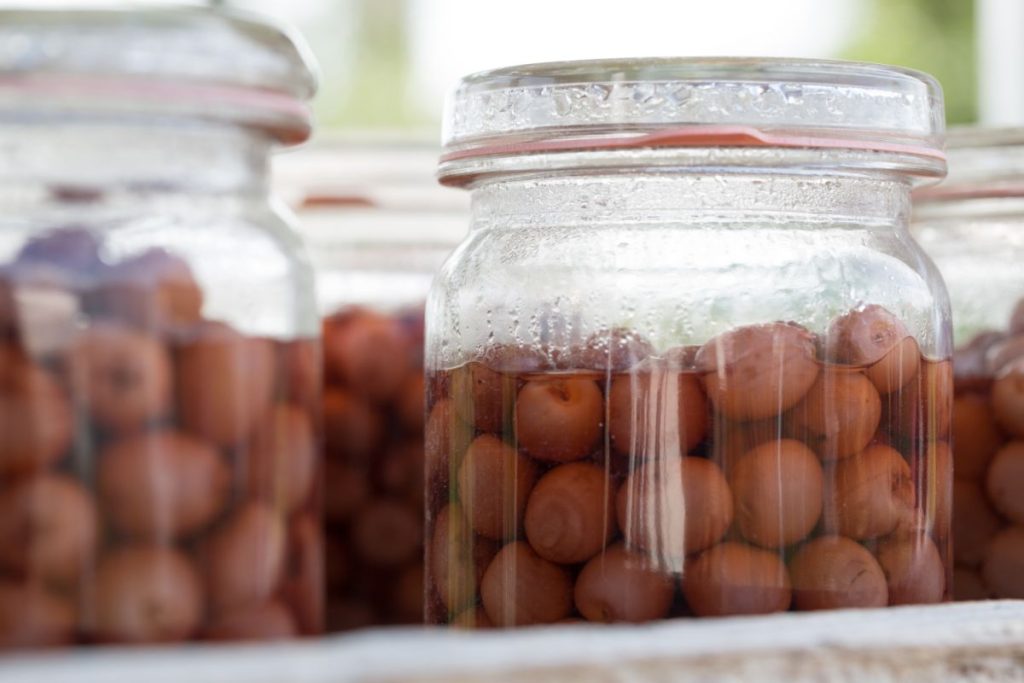Canning cherries is a great way to preserve fresh fruit for later use. Using fresh, ripe cherries and the water bath canning method, home canners can enjoy all the benefits of having tasty cherries in their pantry for months.
Can Fresh Cherries be Canned?
Yes! Fresh cherries are the best choice when it comes to canning cherries. It’s best to pick fresh cherries yourself rather than buy them at the grocery store. This gives you more control over which fruits you’re using.
Cherries do not ripen once picked from the tree, so be sure to pick the ripest cherries possible. Both sweet cherries and sour cherries can be used. Bing cherries are a popular variety and one that’s normally easy to find.
Whether picking fresh cherries from a tree, or buying them, avoid bruised or otherwise damaged fruits for the best quality. Be sure to store the cherries in the refrigerator and wait to wash them until you can begin the canning process for the best results.
What is the Best Canning Method for Preserving Cherries?
Cherries are acidic fruits, and the best canning method for cherries is water bath canning.
Water bath canning involves submerging filled hot jars in boiling water in a large pot or water bath canner and using the heat from the water to make the food safe. Water bath canning is best used for foods with a higher acid content – like fruits, tomatoes, and pickled products.
Pressure canning is recommended for vegetables, meats, soups, and other foods with lower acid content.
Step-by-Step Guide to Canning Cherries
Water bath canning is easy and perfect for fresh cherries, cherry jam, and pickled cherries recipes. It is important that you have all of your equipment and ingredients ready before you begin canning.
You’ll need the following items:
- Ascorbic acid powder or lemon juice
- Canning jars, lids, and screw bands (pint jars or quart jars)
- Canning pot or large, deep pot with a lid
- Canning rack
- Canning tongs or a jar lifter
- Granulated sugar for making sugar syrup
- Ladle
- Large saucepan
- Several pounds of cherries
- Water or fruit juice for the canning liquid
Preparing Cherries for Canning
Fill a bowl with water for your cherries. Add a few tablespoons of lemon juice or a tablespoon of ascorbic acid to the water.
Rinse whole cherries under running water. If you wish to pit them, use a cherry pitter or a knife to carefully remove the pits. Then place your cherries into the water solution.
Allow the cherries to soak for 10 minutes in the solution. This will help prevent discoloration of the cherries.
How to Make Syrup for Cherries
Once your cherries are prepared, it is time to make syrup for them. You’ll have to decide how much sugar to add to your syrup. You can also omit added sugar and use water or fruit juice instead.
Depending on how sweet you want to make your syrup, use the following ratios of water to sugar:
| Type of Syrup | Amount of Sugar | Amount of Water |
| Light syrup | 1 and 1/2 cups | 5 and 3/4 cups |
| Medium syrup | 2 and 1/4 cups | 5 and 1/4 cups |
| Heavy syrup | 3 and 1/4 cups | 5 cups |
To make a simple syrup, add granulated sugar and water to a large saucepan. Heat the water until the sugar dissolves, mixing thoroughly. As the sugar cooks, the mixture will thicken until syrup forms.
It is important to know at this stage whether you’ll hot pack or raw pack the cherries. If you want to hot pack your cherries, you will add your cherries into the pan while making the hot syrup. This mixture of hot cherries and syrup is then ladled directly into sanitized, heated canning jars.
The other option is raw packing, which involves packing clean, hot jars with cherries and then pouring the syrup over the cherries into the jar.
It doesn’t matter which of the two methods you use, although it can be tricky to get hot pack cherries into jars without making a mess. That’s where your ladle will come in handy!
Water-Bath Canning Cherries
Once your sugar syrup and cherries are ready, it is time to process the cherries.
- Fill the canner halfway with water and preheat to 180°F for hot packs or 140°F for raw packs.
- Ensure your canning jars have been sanitized ahead of time by running them through a dishwasher or handwashing them with soap and hot water.
- Before filling your jars, ensure they are heated and wipe the rim to remove any moisture.
- Fill hot canning jars with cherries and your canning liquid, leaving a 2-inch headspace.
- Seal jars and apply screw bands until fingertight.
- Load sealed jars onto the canning rack and lower it carefully into the canner using the handles. Add hot water until the water level is 1 inch above the jars. Cover the canner with a lid.
- When water boils vigorously, lower the heat to maintain a gentle boil. Process for the recommended time according to your altitude, jar size, and packing method in the following table:
| Altitude | 0 – 1,000ft | 1,001 – 3,000ft | 3,001 – 6,000ft | 6,000ft + |
| Hot Pack (pints) | 15 min | 20 min | 20 min | 25 min |
| Hot Pack (quarts) | 20 min | 25 min | 30 min | 35 min |
| Raw Pack (pints or quarts) | 25 min | 30 min | 35 min | 40 min |
Once processed for the recommended time, remove from heat and allow to cool gradually. Wait 5 minutes before using the jar lifter to remove jars from the pot and set them on a rack.
Do not re-tighten the screw bands. Let jars air cool for 12-24 hours. You should hear a popping sound as the jars seal during the cooling process. Once the jars are completely cool, remove the screw bands and check the seals.
If the seal is indented, the jar is safe to label and store in a cool, dark place. If the seal isn’t indented, you can use a new lid and reprocess it, or put the jar into the refrigerator and consume the cherries within a few days.
Do You Have to Pit Cherries Before Canning?
Pitting cherries before canning is optional though many people choose to do it. Pitting cherries can be done by hand with a knife with a cherry pitter.
What is the Difference Between Hot Packing and Raw Packing Cherries?
Raw packing is a canning process where you bring your syrup to a boil, pack your canning jars with the cherries, and pour hot syrup over the cherries inside the jar. Hot packing means that the cherries and syrup are boiled together, then poured into the jars once hot, all in one step.
Raw packing results in cherries that are more likely to float since not as much air is removed from the fruit during the canning process. The fruit also tends to discolor more quickly due to the extra air. This method may be better for people who intend to use the canned cherries relatively quickly, as the longer raw packed cherries are stored, the more discolored they’ll be.
Hot-packed cherries are less likely to discolor than raw-packed cherries. Hot packing also removes more air from the fruit during the cooking process and makes the fruit shrink slightly, allowing you to add more to each jar.
If you’re canning your cherries with less sugar, using plain water or fruit juice such as white grape juice, then it’s recommended to use the hot pack method.

What are the Benefits of Canning Cherries?
One of the best benefits of canning cherries is the convenience of having canned cherries whenever you need them! Canned cherries are great to have on hand when making cherry pie, putting together a cobbler, or using them as an ice cream topping.
Aside from the convenience, cherries are nutritious. Cherries have phytochemicals that have long been touted for their anti-inflammatory properties, which is great for those that suffer from things like arthritis or gout.
Cherries are also known to be high in fiber and contain vitamins like A, C, and K. High fiber is linked to lower rates of colorectal cancer and overall healthier weights and bodies. The vitamins in cherries are essential for a healthy immune system and make your body grow, develop, and function properly.
What is the Shelf Life of Canned Cherries?
Assuming canned cherries have been preserved according to proper methods and stored in a cool, dark place, they can last for years. That said, canned cherries lose quality over time, even if they remain edible.
The shelf-life of canned cherries is 1-3 years. More acidic foods, like canned cherries, tend to lose quality faster than less acidic foods. So aim to consume your cherries within a year for the best quality.

